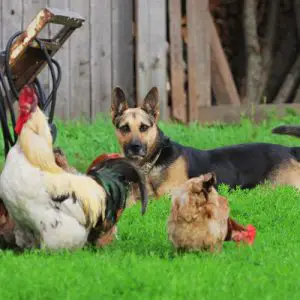Our fur babies are no doubt the light of our lives, but they can also be the source of a lot of our worries. Why? Because dogs cannot communicate their aches, pains, fears, and joys. Instead, dog parents need to monitor their dogs for illnesses and read their body language to understand how they are feeling. One of the important and common emotions dogs feel is stress and anxiety.
They may not exhibit the classic furrowed brows, determined look, and rubbing of the temples many people display when they are stressed. Without these signs, how can we know when our pooches are anxious and stressed out? Look closely, because they are communicating these feelings to you in a more subtle (but obvious if you know what to look for) way.
12 Signs of a Stressed Out Dog
While every dog is different, here are some telltale signs that your dog is stressed out. It’s much easier to curb stress and nip anxiety in the bud when you know you can identify the symptoms. One thing to note is that these signs can all be indicators of a health problem or nothing to worry about if looked at singularly.
You should worry when your dog is displaying behaviors out of the ordinary or a bunch of the symptoms below.
- More Whining/Barking Than Usual
Some dogs can whine and bark on a daily basis (speaking from experience), so this may not always be the best indication of stress. However, if your dog is whining and barking more than usual or there is a distinct trigger (such as another dog walking by the house), then you will know it’s likely due to stress.
The whining or barking comes naturally to most dogs when they feel stressed, which is why it is a big indication of some kind of emotion. Dogs bark when they are happy and excited as well, but when you get to know your dog more, you will be able to tell the slight differences between the type of bark and the emotion it accompanies.
Whining in combination with barking is more likely to indicate some sort of fear, stress, or anxiety rather than excitement. You may also get growling and whimpering with the barking and these vocalizations are all common signs of stress.
- Pacing
Next up is pacing. Many frantic and anxious dogs will pace while vocalizing in a way to self-soothe. Your dog will seem unsettled and antsy. Many of the signs on our list can be due to separation anxiety, which happens when you leave the home. If your dog doesn’t suffer from separation anxiety, then you can keep a lookout to decipher what triggers this behavior to isolate the cause and hopefully treat it.
- Yawning
Dog yawning can be attributed to many emotions. There is a correlation between sleepiness and yawning in dogs just like with humans, but yawns can also be a sign of stress, empathy (you yawn they yawn), and even love and contentment. How do you know if a yawn is just a yawn or if it’s due to stress? You guessed it! Stress yawns usually appear in tandem with other signs of anxiety such as barking, pacing, and drooling, which brings us to the next symptom.
- Drooling
Drooling is a more severe sign of stress. Yes, dogs can drool a lot in general depending on the breed (hello, bulldogs!), but if it’s excessive then it’s most likely caused by stress. One thing to note is that drooling can be a sign of other health issues. Some dogs may drool so much it may seem like they are foaming at the mouth. If your dog is just drooling without signs of stressful triggers and high temperatures, then we would suggest scheduling a vet visit just to make sure he is okay.
- Panting
Panting alone is not a good indicator of stress, because dogs pant when they are excited or when it’s hot out. Panting is very often associated with frantic pacing, and barking/whining, which are classic signs of canine stress.
- Excessive Licking
Excessive licking of the lips, paws, or body is also a self-soothing gesture for dogs. Dogs sometimes self-groom and they also lick their paws due to allergies, so how can you tell the difference? Stress licking is usually only in one spot. Sometimes the licking can cause bald or pink spots to appear on the area your dog licks.
As we said, licking could be due to allergies as well. If your dog has itchy skin and gas or an upset stomach, then the licking could be because of environmental or food triggers. To be sure, you can schedule a quick vet visit. Remember that while there are some tests that can be performed to identify environmental allergies, the best way to be sure of a food allergy is with an elimination diet.
- The Whale Eye
The “whale eye” is a classic sign of stress or a bothered/annoyed dog that wants to be left alone. The whale eye usually accompanies stiff body language. What is a whale eye? It’s a side-eye glance your dog gives you that shows a lot of the whites around his eyes. The whale eye can also happen when your dog is extra stressed and is wide-eyed while pacing and barking.
The whale eye is not to be dismissed. While many dogs give the whale eye as a warning to be left alone, it could also be a precursor to aggression. If you notice the whale eye on your dog, just back away and give him some space.
- Frequent Urination
Incontinence is a more serious sign of stress, but most dogs just urinate more frequently. If you have ever been nervous before an event, you may also notice the need to use the bathroom more often. Keep in mind that this may not be a sign of stress if your dog has had a lot of water or if he is a male dog in the presence of another dog in his territory.
Male dogs engage in “marking” behavior, which is sprinkling pee around their territory to claim it. Your boy dog may feel the need to do this when there is an invading presence in his home. Frequent urination can also be a sign of a health problem such as a urinary tract infection (UTI). If you notice blood in the urine, then definitely schedule a vet visit.
- Defecation Due to Stress
Just like how your dog can lose bladder control, the same can happen to his bowel as well. Many dogs will also poop due to stress (we have one such dog). Sometimes a healthy dog can even have diarrhea due to stress. We have found that a way to prevent stress pooping is by emptying your dog’s bowels beforehand.
For example, if your absence is what triggers the pooping due to separation anxiety, try taking your dog out for a walk prior and your dog won’t be as likely to poop.
- Loss of Appetite
A loss of appetite is one of the biggest signs that something is wrong. When your dog isn’t feeling well or acting right, one of the first things your vet will ask is if he is still eating. A dog that is still active and eating is usually one that’s feeling okay.
Again, a loss of appetite isn’t a sign of stress on its own. There are a plethora of reasons why a dog may refuse his meals, such as spoiled food or even a dog who has overgorged on snacks! However, you should be a little more concerned if your dog is showing signs of franticness along with no interest in his food.
- Hiding or Escaping
This next sign is something humans may do as well. When something is stressful and causes anxiety, most creatures will have the urge to either remove it or run from it. If your dog is scared/stressed out by strangers in your home, then he may communicate this with you by running to or hiding in a place he feels safe.
- It’s All In the Body Language
There are subtle displays in body language your dog could exhibit that signify stress.
- Tucked or flat ears against the head
- No eye contact
- Raised hackles (fur along the length of your dog’s back)
- Tucked or straight tail
- Shaking, shivering, trembling (more common in small to toy breeds)
- Abnormal shedding
- Stiff or hunched body
- The “submission” position flat on your dog’s back (a sign of severe stress and anxiety)
- Destructive behavior
How to Calm a Stressed Out Dog
The best way to calm and soothe a stressed dog is to understand why your dog is feeling this way in the first place. Is it your tone of voice? Is it something triggering him externally? Does he suffer from serious separation anxiety? These are all questions to ask yourself.
It’s very important to figure out the “why” because the treatment method depends on it. You wouldn’t try to calm a dog stressed out by your absence the same way you would when it’s thundering out.
Let’s take a look at some ways you can help alleviate your dog’s concerns.
- Comfort and Affirmation
Comfort your dog if you know he is stressed or scared. Use a soothing and reassuring voice (not one that is overly animated). While your dog may not understand your words, he can definitely understand your tone. You can also pat your dog gently and use aromatherapy or calming supplements if your vet approves.
- Prevention
The best prevention is to not trigger anxiety. You can remove and avoid triggers, but it can be difficult when the situation is outside of your control, such as a dog set off by loud noises. A great way to make your dog less sensitive and reactive is overexposure and sufficient mental and physical exercise.
- Training
Training a dog properly from a young age can also help curb stress in the future. For example, a puppy that was taught to spend time alone and one that was crate trained will be less likely to feel stress in the absence of his human.
You can always enlist the help of a professional if you need help correcting stress that has already manifested. Some pet parents resort to an anti-barking device for dogs who are overly vocal about their stress but before doing that we would advise dog parents to consult with a professional to see if there are more options to try.
- Create a “Safe Place”
Your dog’s crate or room should be a safe space, a place where he wants to go to when he’s tired, scared, happy, or just needs a place to get away from it all. This is why crate training is one of the most important forms of training to engage in from a young age. Make sure to make it a comfortable place with a nice dog bed and maybe a snuggle toy for your dog if appropriate!
- Consistency and Routine
Dogs are habitual creatures and don’t handle change very well (hmm, we know some humans like that too!). One of the foundations of puppy training is consistency and routine. Establishing a set schedule will help your dog ease into a new environment and know what to expect. When you deviate from what they are used to, most dogs get stressed.
We understand that life happens and you will probably move homes at some point, add a new family member, and have a change in your schedule, but it’s important to know how to help your dog adjust when those things occur and to get right back to what routine your pooch is used to.
Conclusion
Anxiety and stress in dogs can be manageable, and it’s perfectly okay if you need some help getting there from a professional. Our fur babies can’t use words to tell us exactly how they are feeling, which is why it’s so crucial to get to know your dog to understand his body language and vocalization so you can know right away when something is wrong. You got this!




